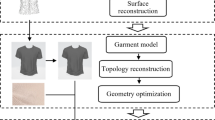Abstract
In digital furniture design, skillful designers usually use professional software to create new furniture designs with various textures and then take advantage of rendering tools to produce eye-catching design results. Generally, a fine- grained furniture model holds many geometric details, inducing significant time cost to model rendering and large data size for storage that are not desired in application scenarios where efficiency is greatly emphasized. To accelerate the rendering process while keeping good rendering results as many as possible, we develop a novel decimation technique which not only reduces the number of faces on furniture models, but also retains their geometric and texture features. Two metrics are utilized in our approach to measure the distortion of texture features. Considering these two metrics as guidance for decimation, high texture distortion can be avoided in simplifying the geometric models. Therefore, we are able to build multi-level representations with different detail levels based on the initial design. Our experimental results show that the developed technique can achieve excellent visual effects on the decimated furniture model.
Similar content being viewed by others
References
Botsch M, Kobbelt L, Pauly M, Alliez P, Lévy B. Polygon Mesh Processing (1st edition). A K Peters/CRC Press, 2010.
Garland M, Heckbert P S. Surface simplification using quadric error metrics. In Proc. the 24th Annual Conference on Computer Graphics and Interactive Techniques, August 1997, pp.209-216.
Lindstrom P. Out-of-core simplification of large polygonal models. In Proc. the 27th Annual Conference on Computer Graphics and Interactive Techniques, July 2000, pp.259-262.
Hoppe H. Efficient implementation of progressive meshes. Computers & Graphics, 1998, 22(1): 27-36.
Schroeder W J, Zarge J A, Lorensen W E. Decimation of triangle meshes. ACM SIGGRAPH Computer Graphics, 1992, 26(2): 65-70.
Luebke D. A survey of polygonal simplification algorithms. Technical Report, University of North Carolina at Chapel Hill, 1997. http://citeseerx.ist.psu.edu/viewdoc/dow-nload?doi=10.1.1.104.3802&rep=rep1&type=pdf, Sept. 2019.
Lubeke D P. A developer’s survey of polygonal simplification. IEEE Computer Graphics and Applications, 2001, 21(3): 24-35.
Talton J O. A short survey of mesh simplification algorithms. Technical Report, University of Illinois at Urbana-Champaign, 2004. https://pdfs.semanticscholar.org/ddc3/59b398e5c7d95ceb4015e65ad4e103d669dd.pdf, Sep. 2019.
Rossignac J, Borrel P. Multi-resolution 3D approximations for rendering complex scenes. In Modeling in Computer Graphics: Methods and Applications, Falcidieno B, Kunii T L (eds.), Springer, 1993, pp.455-465.
Low K L, Tan T S. Model simplification using vertex- clustering. In Proc. the 1997 Symposium on Interactive 3D Graphics, April 1997, pp.75-82.
Reddy M. SCROOGE: Perceptually-driven polygon reduction. Computer Graphics Forum, 1996, 15(4): 191-203.
Luebke D, Erikson C. View-dependent simplification of arbitrary polygonal environments. Technical Report, University of North Carolina at Chapel Hill, 2006. https://apps.dtic.mil/dtic/tr/fulltext/u2/a446958.pdf, Sep. 2019.
Li Y, Zhu Q. A new mesh simplification algorithm based on quadric error metrics. In Proc. the 2008 International Conference on Advanced Computer Theory and Engineering, December 2008, pp.528-532.
Schroeder W J. A topology modifying progressive decimation algorithm. In Proc. the 1997 IEEE Visualization, October 1997, pp. 205-212.
Garland M, Heckbert P S. Simplifying surfaces with color and texture using quadric error metrics. In Proc. the 1998 IEEE Visualization, October 1998, pp.263-269.
Cohen J, Olano M, Manocha D. Appearance-preserving simplification. In Proc. the 25th Annual Conference on Computer Graphics and Interactive Techniques, July 1998, pp.115-122.
Hoppe H. New quadric metric for simplifying meshes with appearance attributes. In Proc. the 1999 IEEE Visualization, October 1999, pp.59-510.
Sander P V, Snyder J, Gortler S J, Hoppe H. Texture mapping progressive meshes. In Proc. the 28th Annual Conference on Computer Graphics and Interactive Techniques, August 2001, pp.409-416.
Lindstrom P, Turk G. Image-driven simplification. ACM Transactions on Graphics, 2000, 19(3): 204-241.
Yao L, Huang S, Xu H, Li P. Quadratic error metric mesh simplification algorithm based on discrete curvature. Mathematical Problems in Engineering, 2015, 2015: Article No. 428917.
Hoppe H. Progressive meshes. In Proc. the 23rd Annual Conference on Computer Graphics and Interactive Techniques, August 1996, pp.99-108.
Author information
Authors and Affiliations
Corresponding author
Electronic supplementary material
ESM 1
(PDF 321 kb)
Rights and permissions
About this article
Cite this article
Pan, ZG., Xian, CH., Jin, S. et al. Progressive Furniture Model Decimation with Texture Preservation. J. Comput. Sci. Technol. 34, 1258–1268 (2019). https://doi.org/10.1007/s11390-019-1974-0
Received:
Revised:
Published:
Issue Date:
DOI: https://doi.org/10.1007/s11390-019-1974-0




